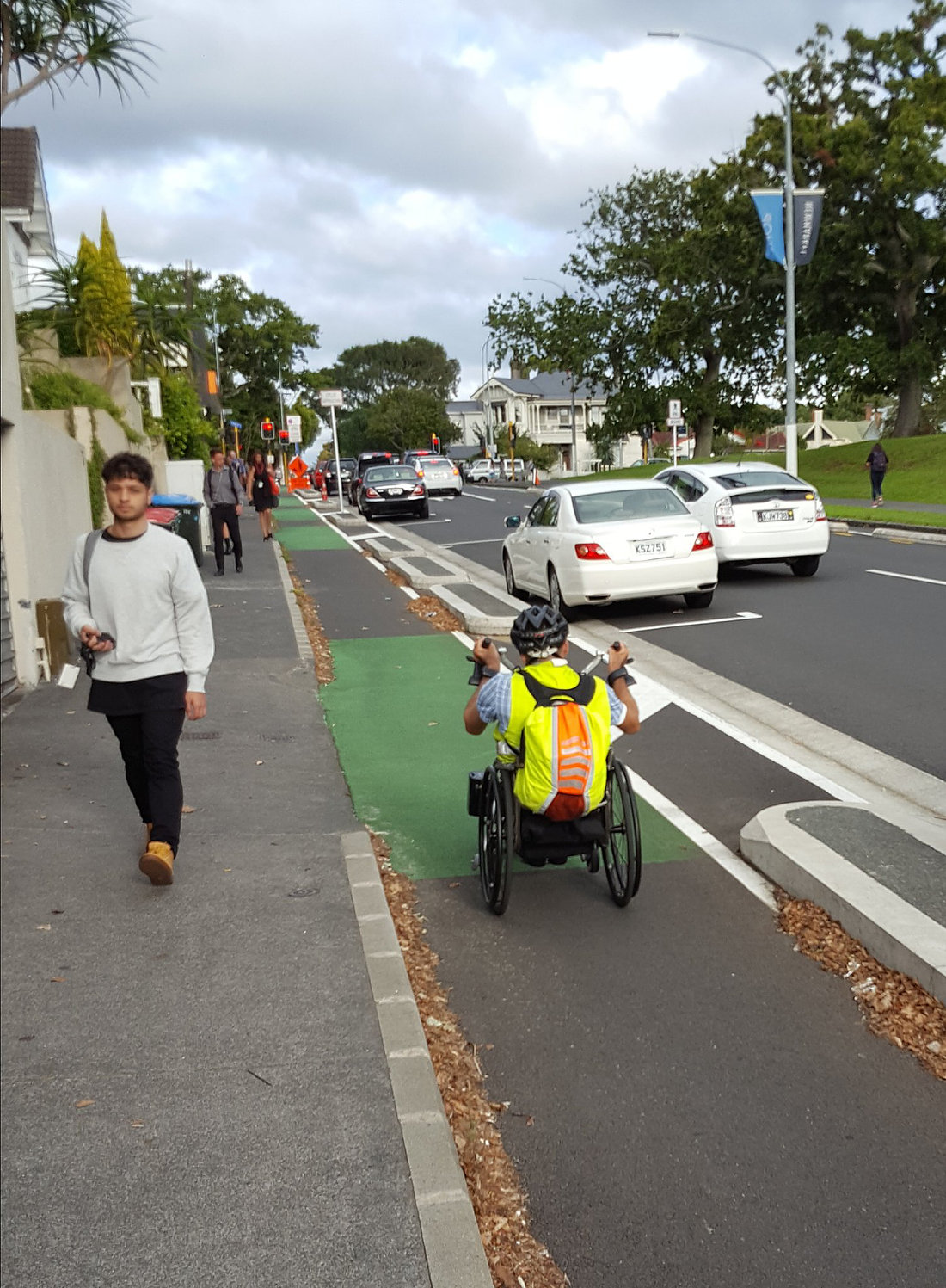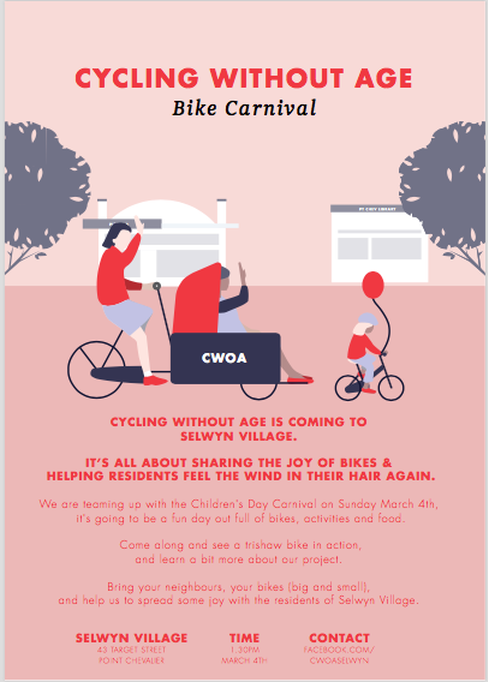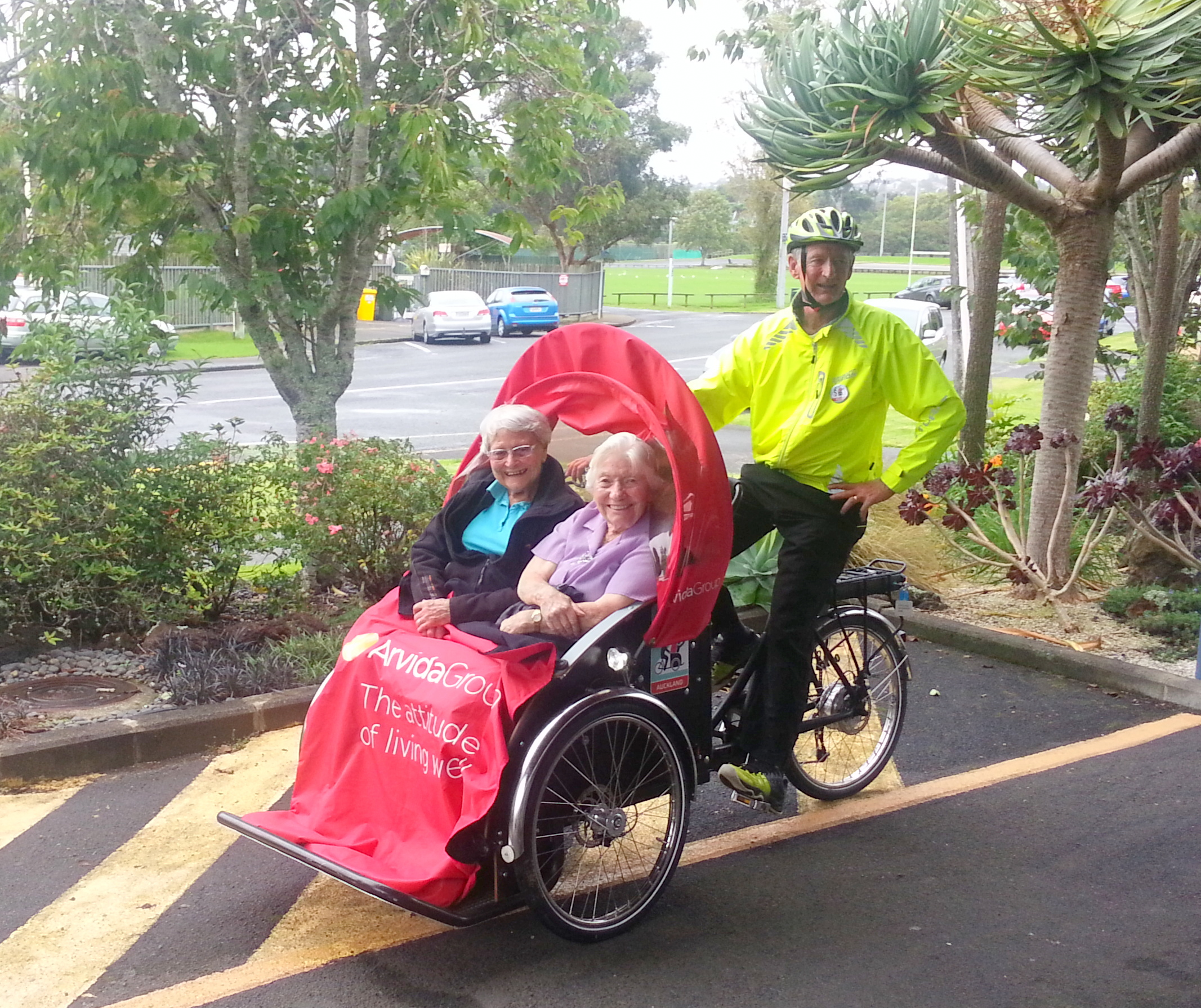One of our most popular posts of all time was about the arrival in Auckland of Cycling Without Age, an international movement that connects volunteer ‘pilots’ with retirement villages, bringing together younger cyclists and elderly people through the love of cycling. Using an electric bike-trishaw, CWOA allows less-mobile residents to enjoy fresh air while exploring the neighbourhood, reactivating memories of childhood bike adventures, and creating new friendships.
So far, Auckland’s sole CWOA outpost has been in Browns Bay on the North Shore. Now, Greer Rasmussen is bringing Cycling Without Age to Selwyn Village in Point Chevalier, and will be launching it at a Bike Carnival in the village on Sunday March 4th 2018. See the flyer and Facebook event here, and if you’d like to stay updated on the project – including learning how to sign up as a volunteer ‘pilot’ – like the Facebook page here.
Below, Greer shares some of the thinking behind the project, what makes it special, and how it will be great for Auckland and its people (republished with permission from here)…
Diversity
60 percent of Aucklanders would like to use bikes (Auckland Transport, 2017), but currently only those with the highest level of confidence and ability can. By encouraging elderly people to get out on bikes, Cycling without Age can show other groups that cycling is possible for them too.
Auckland’s bike culture and existing infrastructure does not currently reflect the diversity that exists in our city. When I am out riding, it appears that majority of cyclists in Auckland are young men in lycra riding road bikes. While there is nothing wrong with this, there aren’t nearly enough cargo bikes, ladies’ bikes or children’s bikes on the roads, and bikes are not being used to their full potential, for commuting and enjoyment as well as sport. As a result, it makes it harder to imagine the full potential of cycling to transform our city.
Cycling without Age encourages a cycling culture where full participation is expected and celebrated, and celebrates the 8-80 ethos, whereby a city will work for everyone if it works for 8- and 80-year-olds. By increasing the diversity of riders on the road, we can start pushing to build infrastructure that caters to a wide range of needs.

Connection
Cycling without Age connects elderly people with young cyclists (or pilots) in the community. The program allows riders and pilots to connect with the world, with their community and with nature.
Social isolation is a huge problem for elderly people in the western world, and New Zealand is no exception. Research has shown that there are more than 60,000 severely lonely older people in New Zealand, and loneliness has been shown to have as bad an effect on health as smoking (Age Concern, 2017).
But it is not just elderly people who will benefit. Young adults have been shown to have high rates of loneliness as well, as family structures change and many families live further apart. Many younger people miss out on the experience of having grandparents and caring for an older person.
Cycling without Age provides young people with the opportunity to get outside into the fresh air, away from their phones, and to make a connection with people in their community. This can have a massive impact on the health and wellbeing of our society.
Car-centric planning policies and motorways have made our cities stratified and separate, and have made it difficult for disadvantaged people to participate fully. Communities have been pushed further apart, making connection more difficult. New approaches to planning are looking to correct this, although it will take a long time to alter the physical makeup of our urban environment. Cycling without Age gives people a here-and-now way to connect with people in their communities across generations.
Joy
Cycling without Age lives by the motto that everyone should have the right to feel the wind in their hair. The joy of cycling is hard to describe but easy to experience, and age shouldn’t limit anyone from that enjoyment.
The project is also a way for us to move the current conversations about cycling away from safety and danger, towards the idea that cycling is a fun, enjoyable and healthy way to get around.
Infrastructure
The infrastructure changes that Cycling without Age encourages will also benefit wheelchair and mobility scooter users, which is especially important given New Zealand’s aging population.
Having just one category of rider on the road limits the design of cycling infrastructure. However, a wider range of riders and bikes on the road makes a strong case for separated infrastructure.
The current road layouts are not protecting our most vulnerable road users. These riders are not as flexible or perhaps as confident as road bike users, who can weave in and out of traffic, and jump curbs. There is also a serious issue with cars not being able to easily see cyclists.
People drive rather than ride because they don’t feel safe, which leads to the roads being even less safe. This self-perpetuating culture of marginalising cycling can be combated with a new approach to infrastructure, helping those less confident riders feel more secure on their bikes. We need more continuous, wide and protected cycle lanes that allow the full range of users to ride safely.
— Greer Rasmussen







